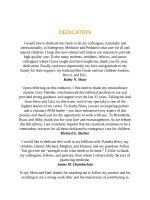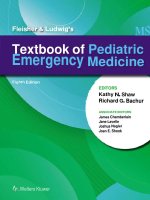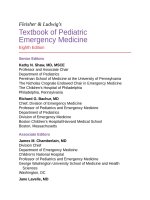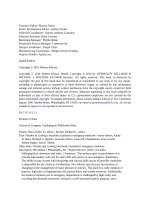Pediatric emergency medicine trisk 0304 0304
Bạn đang xem bản rút gọn của tài liệu. Xem và tải ngay bản đầy đủ của tài liệu tại đây (74.5 KB, 1 trang )
4. Reflective safety wear for each crew member (must meet American
National Standard for High Visibility Public Safety Vests if working within
the right of way of any federal-aid highway. Visit
www.reflectivevest.com/federalhighwayruling.html for more information)
Equipment for ambulances 95
Required equipment: advanced life support (ALS) emergency ground
ambulances
For paramedic services, include all of the required equipment listed above, plus
the following additional equipment and supplies. For advanced EMT services
(and other nonparamedic advanced levels), include all of the equipment from
the above list and selected equipment and supplies from the following list,
based on scope of practice, local need, and consideration of out-of-hospital
characteristics and budget.
A. Airway and ventilation equipment
1. Laryngoscope handle with extra batteries and bulbs
2. Laryngoscope blades, sizes:
a. 0–4, straight (Miller), and
b. 2–4, curved
3. Endotracheal tubes (if ALS service scope of practice includes tracheal
intubation), sizes:
a. 2.5, 3.0, 3.5, 4.0, 4.5, 5.0, and 5.5-mm cuffed and/or uncuffed, and
b. 6.0, 6.5, 7.0, 7.5, and 8.0-mm cuffed (1 each), other sizes optional
4. 10-mL non–Luer Lock syringes
5. Stylets for endotracheal tubes, adult and pediatric
6. Magill forceps, adult and pediatric
7. End-tidal CO2 detection capability (adult and pediatric)
8. Rescue airway device, such as the ETDLA (esophageal–tracheal doublelumen airway), laryngeal tube, disposable supraglottic airway, or laryngeal
mask airway (as approved by local medical direction)
B. Vascular access
1. Isotonic crystalloid solutions
2. Antiseptic solution (alcohol wipes and povidone-iodine wipes preferred)
3. Intravenous fluid bag pole or roof hook
4. Intravenous catheters, 14–24G
5. Intraosseous needles or devices appropriate for children and adults
6. Latex-free tourniquet
7. Syringes of various sizes
8. Needles, various sizes (including suitable sizes for intramuscular
injections)









